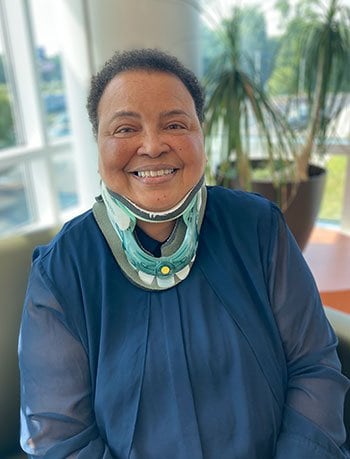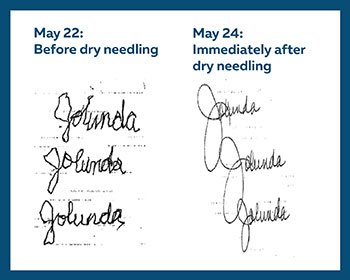Dry Needling Therapy Gives Patient Renewed Hope
 Jolunda Coe
Jolunda Coe
Jolunda Coe, or “Ms. Jo,” has been a social worker with Public Schools of Robeson County for 20 years. She recently underwent a type of physical therapy known as dry needling that showed remarkable results, including an extreme improvement in her handwriting from before and after her first dry needling session.
In November 2022, Coe, 61, of Parkton, was involved in a serious motor vehicle accident which caused her spine to be severed. After having surgery to repair her spine, which required two rods and 14 screws with months of varying degrees of rehabilitation at several facilities, she was referred to UNC Health Southeastern’s Carolina Complete Rehabilitation.
During her most recent course of rehabilitation, a therapist observed Coe’s movements and suggested she would be a good candidate for an acupuncture type of therapy referred to as dry needling.
Dry needling is an effective treatment for chronic pain and various musculoskeletal conditions. The benefits of dry needling are increased when electrical stimulation is added. Dry needling with electrical stimulation allows for increased parasympathetic nervous system activation, increase of blood flow to affected tissue, and increase of the beta endorphins, all of which allow for improved tissue healing and reduced pain.
“I am at a point where I need to get back to my life, to driving and spending time with my grandbaby,” said Coe, who underwent her assessment on May 22. “A large part of my job is processing attendance letters and texts, and behavior treatment plans that have to be signed, so I requested a writing exercise before my first dry needling treatment session. I wrote my name and I thought it was just ugly and not what I thought it should be at this point in my recovery.”
 Handwriting samples from before and immediately after dry needling therapy.
Handwriting samples from before and immediately after dry needling therapy.
On May 24, her physical therapist performed her first dry needling session. She immediately proceeded to her occupational therapy session and was asked what she wanted to do for skill improvement.
“I wanted to try writing again,” said Coe, who wrote her name again on the same piece of paper she used to write her name on May 22.
“It was immediately after the dryneedling and they were so astounded,” said Coe, referring to the improvement they saw in her handwriting. “All of the therapists started filing into the room, one after another, to see the difference,” said Coe.
While Coe had reached a plateau with her current course of therapy, dry needling is causing improvements in her mobility which will enable her to continue rehabilitation and continue to be successful in her therapy treatments.
“Ms. Jo has benefited from physical therapy and especially dry needling,” said UNC Health Southeastern Rehabilitation Director Henry Edwards. “Immediately after dry needling, she says she feels a tremendous reduction in pressure and compression of her cervical spine. The reduction in pressure and increased tissue extensibility has provided her with better cervical range of motion. She has seen improved neck and shoulder pain with abolished muscle spasms and tremors. In addition to reduced pain and better mobility, she has shown improvements in fine motor skills. The reduced spasms and tremors greatly improve her quality of life.”
Coe is eager to share her experience in hopes of helping others.
“Whatever I can do within God’s power to help someone else, I am wiling to do,” said Coe.
To learn more about dry needling, contact UNC Health Southeastern’s Carolina Complete Rehabilitation, located at 4901 Dawn Drive, Suite 3200, Lumberton, at (910) 618-9807.